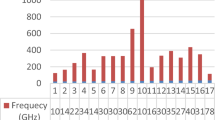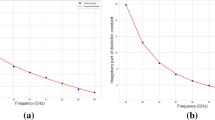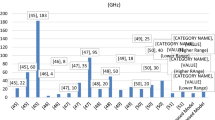Abstract
In case of future telecommunication technologies, extremely high data rates above 100 Gbps is the expectations, which can be fulfilled by utilizing higher spectrum bands. Higher frequency bands like terahertz wave bands are expected to have far broader bandwidths then 5G, therefore 6G will need to encourage R&D activities to utilize so called terahertz waves with frequencies ranging from 100 to 200 GHz. The challenge in utilizing these higher frequency bands is their sensitive nature toward outdoor environmental conditions like cloud, Fog, dust and Rain. To address these issues, this paper proposes a Machine Learning Model based on Artificial Neural Network to predict the attenuation caused due to Clouds and Fog at D and G bands. The model was trained using AMSER–2 Satellite data. The trained model is further optimized using different optimizing techniques. Obtained results was compared with the different existing models.


















Similar content being viewed by others
Availability of data and material
All data used in this research are available. We can provide whenever ask to do so.
Code availability
(software application or custom code): all codes used in this research are available. We can provide whenever ask to do so.
References
Perspectives, Theodore S. Rappaport for CNN business. Opinion: Think 5G is exciting? Just wait for 6G. CNN. https://news.knowledia.com/US/en/articles/opinion-think-5g-is-exciting-just-wait-for-6g-397fc91bf15b9de09d376a11e9267f9b1cd486b7.
Kharpal, A. (2019). China starts development of 6G, having just turned on its 5G mobile network. CNBC. https://www.cnbc.com/2019/11/07/china-starts-6g-development-having-just-turned-on-its-5g-mobile-network.html.
Boxall, A., Lacoma, T. (2021). What is 6G, how fast will it be, and when is it coming?. DigitalTrends. Retrieved February 18, 2021. https://www.digitaltrends.com/mobile/what-is-6g/.
Li, J. Forget about 5G, China has kicked off its development of 6G. Quartz. https://qz.com/1743790/forget-5g-china-begins-development-of-6g/
"6G: What It Is & When to Expect It". Lifewire. https://www.lifewire.com/6g-wireless-4685524.
Dohler, M., Mahmoodi, T., Lema, M. A., Condoluci, M., Sardis, F., Antonakoglou, K., Aghvami, H. (2017). Internet of skills, where robotics meets AI, 5G and the Tactile internet. 2017 European Conference on Networks and Communications (EuCNC) 1–5 https://doi.org/10.1109/EuCNC.2017.7980645. ISBN 978-1-5386-3873-6. S2CID 32801348.
Saad, W., Bennis, M., & Chen, M. (2020). A vision of 6G wireless systems: applications, trends, technologies, and open research problems. IEEE Network, 34(3), 134–142. https://doi.org/10.1109/MNET.001.1900287.ISSN1558-156X.S2CID67856161
De Alwis, C., Kalla, A., Pham, Q.-V., Kumar, P., Dev, K., Hwang, W.-J., & Liyanage, M. (2021). Survey on 6G frontiers: Trends, applications, requirements, technologies and future research. IEEE Open Journal of the Communications Society, 2, 836–886. https://doi.org/10.1109/OJCOMS.2021.3071496
Yang, H., Alphones, A., Xiong, Z., Niyato, D., Zhao, J., Wu, K. (2020). Artificial-intelligence-enabled intelligent 6G networks. https://doi.org/10.1109/MNET.011.2000195. ISSN 1558–156X. S2CID 209324400.
Xiao, Y., Shi, G., Li, Y., Saad, W., & Poor, H. V. (2020). Toward self-learning edge intelligence in 6G. IEEE Communications Magazine., 58(12), 34–40. https://doi.org/10.1109/MCOM.001.2000388. ISSN 1558-1896.
Guo, W. (2020). Explainable artificial intelligence for 6G: Improving trust between human and machine. IEEE Communications Magazine., 58(6), 39–45. https://doi.org/10.1109/MCOM.001.2000050
https://www.policytracker.com/blog/what-does-6g-mean-for-spectrum-policy/
https://www.wilsoncenter.org/article/us-and-eu-approaches-6g
Golovachev, Y., Etinger, A., Pinhasi, G. A., & Pinhasi, Y. (2019). Propagation properties of sub-millimeter waves in foggy conditions. Journal of Applied Physics, 125(15), 151612.
Federici, J. F., Ma, J., & Moeller, L. (2016). Review of weather impact on outdoor terahertz wireless communication links. Nano Communication Networks, 10, 13–26.
Su, K., Moeller, L., Barat, R. B., & Federici, J. F. (2012). Experimental comparison of terahertz and infrared data signal attenuation in dust clouds. JOSA A, 29(11), 2360–2366.
Siles, G. A., Riera, J. M., & García-del-Pino, P. (2012). Atmospheric attenuation at 100 and 300 GHz estimated with radiosonde data. In 2012 6th European Conference on Antennas and Propagation (EUCAP) (pp. 567–571). IEEE.
Suen, J. Y., Fang, M. T., & Lubin, P. M. (2014). Global distribution of water vapor and cloud cover–sites for high-performance THz applications. IEEE Transactions on Terahertz Science and Technology, 4(1), 86–100.
Xing, Y., & Rappaport, T. S. (2021). Terahertz wireless communications: Co-sharing for terrestrial and satellite systems above 100 GHz. IEEE Communications Letters.
Al-Saegh, A. M., Sali, A., Mandeep, J. S., Ismail, A., Al-Jumaily, A. H., & Gomes, C. (2014). Atmospheric propagation model for satellite communications. MATLAB Applications for the Practical Engineer, 2, 249–275.
Tamosiunaite, M., Tamosiunas, S., Zilinskas, M., & Valusis, G. (2017). Atmospheric attenuation of the terahertz wireless networks. Broadband Communications Networks-Recent Advances and Lessons from Practice, 143–156.
Federici, J. F., Ma, J., & Moeller, L. (2015). Weather impact on outdoor terahertz wireless links. In Proceedings of the Second Annual International Conference on Nanoscale Computing and Communication (pp. 1–6).
Moon, E. B., Jeon, T. I., & Grischkowsky, D. R. (2015). Long-path THz-TDS atmospheric measurements between buildings. IEEE Transactions on Terahertz Science and Technology, 5(5), 742–750.
Zhang, Q., Wang, H., & Ma, J. (2015). On the extinction characteristics of terahertz wave in fog. In Proc. Of Joint International Mechanical, Electronic and Information Technology Conference (JIMET 2015).
Kokkoniemi, J., Jornet, J. M., Petrov, V., Koucheryavy, Y., & Juntti, M. (2021). Channel modeling and performance analysis of airplane-satellite terahertz band communications. IEEE Transactions on Vehicular Technology, 70(3), 2047–2061.
Etinger, A., Golovachev, Y., Pinhasi, G. A., & Pinhasi, Y. (2019). Dielectric characterization of fog in the terahertz regime. Acta Physica Polonica A, 136, 749–753.
Lai, Z., Yi, H., Guan, K., Ai, B., Zhong, W., Dou, J., & Zhong, Z. (2020). Impact of meteorological attenuation on channel characterization at 300 GHz. Electronics, 9(7), 1115.
Sheikh, F., Zarifeh, N., & Kaiser, T. (2016). Terahertz band: Channel modelling for short-range wireless communications in the spectral windows. IET Microwaves, Antennas & Propagation, 10(13), 1435–1444.
Mondal, T., Maity, S., Ghatak, R., & Bhadra Chaudhuri, S. R. (2018). Design and analysis of a wideband circularly polarised perturbed psi-shaped antenna. IET Microwaves, Antennas & Propagation, 12(9), 1582–1586.
Jing, Q., & Liu, D. (2018). Study of atmospheric attenuation characteristics of terahertz wave based on line-by-line integration. International Journal of Communication Systems, 31(12), e3718.
Piraquive, F. N. D., Martínez, O.S., Pérez, E. V., Crespo, R. G., Knowledge Cabrera-Mercader, C. R., & Staelin, D. H. (1995). Passive microwave relative humidity retrievals using feed forward neural networks. IEEE Transactions on Geoscience and Remote Sensing, 33(6), 1324-1328.
da Silveira, R. B., & Holt, A. R. (2001). An automatic identification of clutter and anomalous propagation in polarization-diversity weather radar data using neural networks. IEEE transactions on geoscience and remote sensing, 39(8), 1777–1788.
Pazmany, A. L., Sekelsky, J. B. M. S. M., McLaughlin, D. J., & Bluestein, H. B. (2001). 2B. 1 multi-frequency radar estimation of cloud and precipitation properties using an artificial neural network. In Conference on radar meteorology of the american meteorological society. American Meteorological Society (Vol. 30, pp. 154–156).
Choudhury, S., Mitra, S., & Pal, S. K. (2003). Neurofuzzy classification and rule generation of modes of radiowave propagation. IEEE Transactions on Antennas and Propagation, 51(4), 862–871.
Barthes, L., Mallet, C., & Gole, P. (2003). Neural network model for atmospheric attenuation retrieval between 20 and 50 GHz by means of dual-frequency microwave radiometers. Radio science, 38(5), 3–1.
Barthes, L., Mallet, C., & Brisseau, O. (2006). A neural network model for the separation of atmospheric effects on attenuation: Application to frequency scaling. Radio science, 41(04), 1–11.
Singh, H et al. Proposed model for radio wave attenuation due to rain (RWAR) (vol 115, pg 791, 2020)." Wireless Personal Communications (2021).
Singh, H., et al. (2020). An empirical model for prediction of environmental attenuation of millimeter waves. Wireless Personal Communications, 115(1), 809–826.
Singh, H. et al. An intelligent model for prediction of attenuation caused by rain based on machine learning techniques. 2020 International Conference on Contemporary Computing and Applications (IC3A). IEEE, 2020.
Singh, H., et al. (2022). A smart model for prediction of radio wave attenuation due to clouds and fog (SMRWACF). Wireless Personal Communications, 122(4), 3227–3245.
Kumar, V., et al. (2021). Soft clustering for enhancing ITU rain model based on machine learning techniques. Wireless Personal Communications, 120(1), 287–305.
Singh, H. et al. Prediction of radio wave attenuation due to clouds using ANN and its business aspects. In 2021 29th National Conference with International Participation (TELECOM). IEEE, 2021.
Singh, H., et al. Prediction of radio wave attenuation due to cloud using machine learning techniques. 2021 56th International Scientific Conference on Information, Communication and Energy Systems and Technologies (ICEST). IEEE, 2021.
Kumar, V., et al. Approximations for ITV rain model using machine learning. 2021 56th International Scientific Conference on Information, Communication and Energy Systems and Technologies (ICEST). IEEE, 2021.
Kumar, Vivek, et al. An ANN model for predicting radio wave attenuation due to rain and its business aspect. 2021 29th National Conference with International Participation (TELECOM). IEEE, 2021.
Singh, H., Kumar, V., Saxena, K., & Bonev, B. (2021). Computational intelligent techniques for prediction of environmental attenuation of millimeter waves. Security and Privacy Issues in IoT Devices and Sensor Networks, 263–284.
Singh, H., Prasad, R., & Bonev, B. (2018). The studies of millimeter waves at 60 GHz in outdoor environments for IMT applications: A state of art. Wireless Personal Communications, 100(2), 463–474.
Singh, H., Bonev, B., & Chandra, A. (2018). Effects of atmospheric impairments of satellite link operating in Ka band. Wireless Personal Communications, 101(1), 425–437.
Attenuation due to cloud and fog, Recommendation ITU-R P.840–5, P Series Radio wave propagation.
Wentz, F. J., Meissner, T., Gentemann, C., Hilburn, K. A. Scott, J. 2014: remote sensing systems GCOM-W1 AMSR2 [Daily data] Environmental Suite on 0.25 deg grid, Remote Sensing Systems, Santa Rosa, CA.
Funding
This work was not supported by the financial Grant from any organization.
Author information
Authors and Affiliations
Contributions
Did work for machine learning model for cloud attenuation which will be helpful in 6G implementation. Add state of art for cloud attenuation in last few years. Implement machine and AI based model for radio wave propagation particular for terahertz waves.
Corresponding author
Ethics declarations
Conflict of interest
There is no any conflicts of interest.
Additional information
Publisher's Note
Springer Nature remains neutral with regard to jurisdictional claims in published maps and institutional affiliations.
Rights and permissions
Springer Nature or its licensor (e.g. a society or other partner) holds exclusive rights to this article under a publishing agreement with the author(s) or other rightsholder(s); author self-archiving of the accepted manuscript version of this article is solely governed by the terms of such publishing agreement and applicable law.
About this article
Cite this article
Singh, H., Kumar, V., Saxena, K. et al. Smart Channel Modelling for Cloud and Fog Attenuation Using ML for Designing of 6G Networks at D and G Bands. Wireless Pers Commun 129, 1669–1692 (2023). https://doi.org/10.1007/s11277-023-10201-0
Accepted:
Published:
Issue Date:
DOI: https://doi.org/10.1007/s11277-023-10201-0




